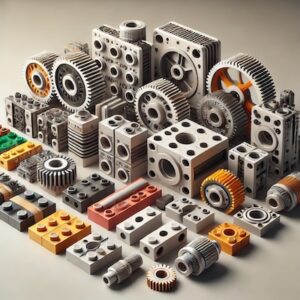
The Superiority of Small, Mass-Produced Industry 4.0 Platforms over Large, Unique Plants: Quality and OPEX Advantages
The evolution of industrial platforms has seen a shift from large, one-of-a-kind plants to smaller, modular, and mass-produced systems powered by Industry 4.0 technologies. This shift is driven by the need for flexibility, efficiency, and enhanced performance metrics. Small, modular platforms outshine their larger counterparts in several ways, particularly when it comes to operational excellence (OPEX) and quality.
1. Enhanced Quality Through Standardization
Small, mass-produced platforms leverage standardized components and production processes, ensuring consistent quality across all units. In contrast, large, unique plants often face challenges in maintaining uniform quality due to their custom-built nature and dependence on bespoke designs. The modular approach enables manufacturers to adopt rigorous quality control measures, automated monitoring, and predictive maintenance tools, all hallmarks of Industry 4.0.
Key benefits include:
- Consistent Outputs: Standardized systems reduce variability in production outcomes.
- Real-Time Monitoring: Industry 4.0 technologies enable advanced data analytics, ensuring any quality deviations are immediately identified and corrected.
- Continuous Improvement: Iterative upgrades across modular platforms are easier to implement, ensuring they stay ahead of technological advancements.
2. Lower Operational Expenditure (OPEX)
Operational efficiency is at the core of small, modular platforms. Their scalability and adaptability provide a significant edge in controlling costs.
- Energy Efficiency: Smaller platforms are designed to optimize energy consumption, often employing smart sensors and AI-driven algorithms to minimize waste.
- Reduced Downtime: Modular platforms simplify maintenance and allow for isolated repairs without halting the entire operation, unlike large plants, which often require costly shutdowns.
- Resource Optimization: The flexible design allows companies to scale operations up or down based on demand, reducing unnecessary expenditures during low-demand periods.
- Predictive Maintenance: With advanced IoT-enabled sensors, these systems detect issues before they lead to failures, significantly lowering repair costs and downtime.
3. Flexibility and Scalability
In an era where market demands shift rapidly, the ability to adapt is crucial. Small, modular platforms provide unparalleled flexibility compared to the rigid, fixed designs of large plants.
- Rapid Deployment: Modular platforms can be quickly installed or relocated, allowing businesses to respond swiftly to changes in production requirements or market location shifts.
- Scalability: Companies can incrementally expand capacity by adding new modules rather than overhauling an entire system.
- Customization: Unlike unique large plants, which require lengthy and expensive design phases, modular systems can be tailored to specific needs by combining pre-designed units.
4. Risk Mitigation
Small platforms distribute risk more effectively than large, centralized plants. A failure in a modular system affects only a part of the operation, whereas issues in large plants can bring entire production lines to a halt. Additionally, mass-produced platforms benefit from economies of scale in parts sourcing and repairs, reducing both time and cost impacts.
5. Embracing Industry 4.0 Innovations
The integration of Industry 4.0 technologies—such as AI, IoT, and machine learning—further amplifies the advantages of small, modular platforms. These systems thrive on interconnectedness, using data-driven insights to enhance performance, reduce waste, and improve decision-making. Large, unique plants often struggle to retrofit these innovations due to their bespoke nature and complex infrastructures.

